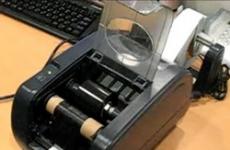Application of lm317 for LEDs. Characteristics, switching on MS lm317, circuit, current stabilizer. Pinout of the microcircuit and transistor
The microcircuit has been a hit among novice radio amateurs for decades due to its simplicity and reliability. Based on this chip, you can assemble an adjustable power supply based on LM317, a current stabilizer, an LED driver and other power supplies. This will require several external radio components; for LM317, the switching circuit works immediately, no configuration is required.
The LM317 and LM317T datasheet microcircuits are completely identical, differing only in the housing. There are no differences or differences, not at all.
I also wrote reviews and datasheets of other popular ICs. With good illustrations, clear and simple diagrams.

- 1. Characteristics
- 2. Analogues
- 3. Typical connection diagrams
- 4. Calculators
- 5. Connection circuits
- 6. Radio constructors
- 7. Datasheet
Characteristics

The main purpose is to stabilize positive voltage. The adjustment occurs in a linear manner, unlike pulse converters.
The LM317T is also popular, I haven’t come across it, so I had to search for a long time for the correct datasheet for it. It turned out that they are completely identical in parameters; the letter “T” at the end of the marking indicates the TO-220 1.5 Ampere housing.
Download datasheets:
- full ;
Characteristics

Even with integrated protection systems, it should not be operated at its maximum capacity. If it fails, it is not known how many volts will be at the output, it will be possible to burn an expensive load.

I will give the main electrical characteristics from the LM317 datasheet in Russian. Not everyone knows technical terms in English.

The datasheet indicates a huge scope of application; it’s easier to write where it is not used.

Analogs

There are many microcircuits that have almost the same functionality, domestic and foreign. I will add more powerful analogues to the list to avoid including several in parallel. The most famous LM317 analogue is the domestic KR142EN12.
- LM117 LM217 – extended operating temperature range from -55° to +150°;
- LM338, LM138, LM350 - analogues for 5A, 5A and 3A, respectively;
- LM317HV, LM117HV - output voltage up to 60V, if the standard 40V is not enough for you.
Complete analogues:
- GL317;
- SG317;
- UPC317;
- ECG1900.


Typical connection diagrams




 Regulator 1.25 - 20 Volts with adjustable current
Regulator 1.25 - 20 Volts with adjustable current








Calculators

To make calculations as easy as possible based on the LM317T, many LM317 calculator programs and online calculators have been developed. By specifying the initial parameters, you can immediately calculate several options and see the characteristics of the required radio components.
A program for calculating voltage and current sources taking into account LM317 characteristics of LM317T. Calculation of circuits for switching on powerful converters using transistors, TL431, M5237. Also IC 7805, 7809, 7812.
Connection schemes

The LM317 stabilizer has proven itself to be a universal microcircuit capable of stabilizing voltage and Amperes. Over decades, hundreds of LM317T switching circuits for various applications have been developed. The main purpose is a voltage stabilizer in power supplies. To increase the number of amperes at the output there are several options:
- connection in parallel;
- installing power transistors at the output, we get up to 20A;
- replacement with powerful analogues LM338 up to 5A or LM350 up to 3A.
To build a bipolar power supply, negative voltage stabilizers LM337 are used.
I think that parallel connection is not the best option due to the difference in the characteristics of the stabilizers. It is impossible to set several pieces to exactly the same parameters in order to distribute the load evenly. Due to the spread, one will always have more load than the others. The probability of failure of a loaded element is higher; if it burns, the load on others, which may not withstand it, will sharply increase.
In order not to connect in parallel, it is better to use transistors at the output for the power part of the DC-DC voltage converter. They are designed for high current and have better heat dissipation due to their large size.

Modern pulse chips are inferior in popularity, but their simplicity is hard to beat. The lm317 current stabilizer for LEDs is easy to set up and calculate, and is currently still used in small-scale production of electronic components.





Bipolar power supply LM317 and LM337, for obtaining positive and negative voltage.




Radio constructors

For beginner radio amateurs, I can recommend radio designers from the Chinese on Aliexpress. Such a constructor is the best way to assemble a device according to the switching diagram; there is no need to make a board and select parts. Any designer can be modified at your own discretion, the main thing is that there is a board. The cost of the designer starts from 100 rubles with delivery, the ready-made module assembled from 50 rubles.

Datasheet
The microcircuit is very popular, produced by many manufacturers, including Chinese. My colleagues came across LM317 with poor parameters that do not draw the declared current. We bought it from the Chinese, who like to fake and copy everything, while worsening the characteristics.








A high-quality power supply with adjustable output voltage is the dream of every novice radio amateur. In everyday life, such devices are used everywhere. For example, take any charger for a phone or laptop, power supply for a children's toy, game console, landline phone, and many other household appliances.
As for the circuit implementation, The design of the sources may be different:
- with power transformers, a full-fledged diode bridge;
- pulse converters of mains voltage with adjustable output voltage.
But in order for the source to be reliable and durable, it is better to choose a reliable element base for it. This is where difficulties begin to arise. For example, choosing domestically produced components as regulating, stabilizing components, the lower voltage threshold is limited to 5 V. But what if 1.5 V is required? In this case, it is better to use imported analogues. Moreover, they are more stable and practically do not heat up during operation. One of the most widely used is integral stabilizer lm317t.
Main characteristics, chip topology
 The lm317 chip is universal. It can be used as a stabilizer with a constant output voltage and as an adjustable stabilizer with high efficiency. MS has high practical characteristics that make it possible to use it in various charger circuits or laboratory power supplies. At the same time, you don’t even have to worry about reliable operation under critical loads, because the microcircuit is equipped with internal short circuit protection.
The lm317 chip is universal. It can be used as a stabilizer with a constant output voltage and as an adjustable stabilizer with high efficiency. MS has high practical characteristics that make it possible to use it in various charger circuits or laboratory power supplies. At the same time, you don’t even have to worry about reliable operation under critical loads, because the microcircuit is equipped with internal short circuit protection.
This is a very good addition, because the maximum output current of the stabilizer on lm317 is no more than 1.5 A. But having protection will prevent you from accidentally burning it. To increase the stabilization current, it is necessary to use additional transistors. Thus, currents of up to 10 A or more can be regulated using the appropriate components. But we’ll talk about this later, and in the table below we’ll present main characteristics of the component.
Microcircuit pinout
An integrated circuit was manufactured in a standard TO-220 package with a heat sink mounted on a radiator. As for the numbering of the pins, they are located according to GOST from left to right and have the following meaning:
Pin 2 is connected to a heatsink without an insulator, so in devices if the heatsink is in contact with the case, mica insulators must be used or any other heat-conducting material. This is an important point, because you can accidentally short-circuit the pins, and there will simply be nothing at the output of the microcircuit.
Analogs lm317
 Sometimes it is not possible to find the specifically required microcircuit on the market, then you can use similar ones. Among the domestic components on lm317, there is an analogue that is quite powerful and productive. He is microcircuit KR142EN12A. But when using it, it is worth considering the fact that it is unable to provide a voltage less than 5 V at the output, so if this is important, you will again have to use an additional transistor or find exactly the required component.
Sometimes it is not possible to find the specifically required microcircuit on the market, then you can use similar ones. Among the domestic components on lm317, there is an analogue that is quite powerful and productive. He is microcircuit KR142EN12A. But when using it, it is worth considering the fact that it is unable to provide a voltage less than 5 V at the output, so if this is important, you will again have to use an additional transistor or find exactly the required component.
As for the form factor, the KR has the same number of pins as the lm317 has. Therefore, you don’t even have to redo the circuit of the finished device in order to adjust the parameters of the voltage regulator or unchangeable stabilizer. When installing an integrated circuit It is recommended to install it on a radiator with good heat dissipation and cooling system. This is quite often observed in the manufacture of powerful LED lamps. But at rated load the device generates a little heat.
In addition to the domestic integrated circuit KR142EN12, more powerful imported analogues are produced, the output currents of which are 2-3 times higher. Such microcircuits include:
- lm350at, lm350t - 3 A;
- lm350k - 3 A, 30 W in another case;
- lm338t, lm338k - 5 A.
Manufacturers of these components guarantee higher output voltage stability, low regulation current, increased power with the same minimum output voltage of no more than 1.3 V.
Connection features
 On the lm317t, the switching circuit is quite simple and consists of a minimum number of components. However, their number depends on the purpose of the device. If a voltage stabilizer is being manufactured, it will require the following parts:
On the lm317t, the switching circuit is quite simple and consists of a minimum number of components. However, their number depends on the purpose of the device. If a voltage stabilizer is being manufactured, it will require the following parts:
Rs is a shunt resistance, which also acts as a ballast. Select a value of about 0.2 Ohm if you want to provide a maximum output current of up to 1.5 A.
The resistive divides with R1, R2, connected to the output and the housing, and the regulating voltage comes from the middle point, forming deep feedback. Due to this, a minimum ripple coefficient and high stability of the output voltage are achieved. Their resistance is selected based on the ratio 1:10: R1=240 Ohm, R2=2.4 kOhm. This is a typical voltage regulator circuit with an output voltage of 12 V.
If you need to design a current stabilizer, This will require even fewer components:
R1, which is a shunt. They set the output current, which should not exceed 1.5 A.
To correctly calculate the circuit of a particular device, always you can use the lm317 calculator. As for the calculation of Rs, it can be determined using the usual formula: Iout. = Uop/R1. On lm317, the LED current stabilizer is of quite high quality, which can be made of several types depending on the power of the LED:
- to connect a single-watt LED with a current consumption of 350 mA, you must use Rs = 3.6 Ohm. Its power is selected to be at least 0.5 W;
- to power three-watt LEDs, you will need a resistor with a resistance of 1.2 Ohm, the current will be 1 A, and the dissipation power will be at least 1.2 W.
On lm317, the LED current stabilizer is quite reliable, but it is important to correctly calculate the shunt resistance and select its power. A calculator will help in this matter. Also, various powerful lamps and homemade spotlights are made using LEDs and based on this MS.
Building powerful regulated power supplies
 The internal transistor lm317 is not powerful enough, to increase it you will have to use external additional transistors. In this case, components are selected without restrictions, because their control requires much lower currents, which the microcircuit is quite capable of providing.
The internal transistor lm317 is not powerful enough, to increase it you will have to use external additional transistors. In this case, components are selected without restrictions, because their control requires much lower currents, which the microcircuit is quite capable of providing.
The lm317 regulated power supply with an external transistor is not much different from the usual one. Instead of a constant R2, a variable resistor is installed, and the base of the transistor is connected to the input of the microcircuit through an additional limiting resistor that turns off the transistor. A bipolar switch with p-n-p conductivity is used as a controlled one. In this design, the microcircuit operates with currents of about 10 mA.
When designing bipolar power supplies you will need to use the complementary pair of this chip, which is lm337. And to increase the output current, a transistor with n-p-n conductivity is used. In the reverse arm of the stabilizer, the components are connected in the same way as in the upper arm. The primary circuit is a transformer or a pulse unit, which depends on the quality of the circuit and its efficiency.
Some features of working with the lm317 chip
When designing power supplies with a low output voltage, at which the difference between the input and output values does not exceed 7 V, it is better to use other, more sensitive microcircuits with an output current of up to 100 mA - LP2950 and LP2951. At low drop, lm317 is not able to provide the required stabilization coefficient, which can lead to unwanted pulsations during operation.
Other practical circuits on lm317
In addition to conventional stabilizers and voltage regulators based on this chip, there are also Can you make a digital voltage regulator?. To do this, you will need the microcircuit itself, a set of transistors and several resistors. By turning on the transistors and upon receipt of a digital code from a PC or other device, the resistance R2 changes, which also leads to a change in the circuit current within the voltage range from 1.25 to 1.3 V.
Let's consider the simplest option for making an LED driver with your own hands with minimal time investment. To calculate the current stabilizer on LM317 for LEDs, we use a calculator, which needs to indicate the required current strength for LED diodes. First draw up a circuit for switching on the LEDs, taking into account the maximum power of the microcircuit and the unit. Look for a cooling system for the entire structure in advance.

- 1. Connection diagram
- 2. Example of calculations and assembly
- 3. Basic electrical characteristics
- 4. Pulse drivers
Calculator
Connection diagram

To make a current stabilizer on LM317 with the ability to regulate, instead of a constant resistor, install a powerful variable resistance. The variable resistance rating can be calculated by specifying the control limits to the calculator. The resistance can be from 1 to 110 Ohms, this corresponds to the maximum and minimum. But I recommend refusing to adjust the Amperes in the load with variable resistance. It will be difficult to implement correctly and the heating will be too high.
The power of a constant resistor for heat dissipation should be with a reserve, calculated by the formula:
- I² * R = Pw
current squared multiplied by the resistance of the resistor.
A transformer or switching voltage source with polar voltage can be used as a power supply. As a rectifier, it is better to use a classic diode bridge, after which a large capacitor is installed.
The current regulator does not operate on a linear principle, so it can get quite hot due to its low efficiency. Having a decent radiator is a must. If the heating control shows a low heating temperature, it can be reduced.

If the number of Amperes required is more than 1.5A, then a couple of elements must be added to the standard circuit. You can get up to 10A by installing a powerful KT825A transistor and a 10-ohm resistor.
This option is suitable for those who do not have an LM338 or LM350 on hand.

The 3A version of the current stabilizer is made on the KT818 transistor. The amperes in the load are regulated and calculated in all circuits the same way on a calculator.
Example of calculations and assembly

If you really want to assemble it but don’t have a suitable power supply, then there are several options to solve this. Barter with a neighbor or connect the circuit to a 9V battery like Krona. The photo shows the entire circuit assembled with an LED.
If 1A is required for LEDs, then we indicate this in the calculator and get a result of 1.25 ohms. There is no resistor of exactly the same value, so we install a suitable one with a value in the direction of increasing Ohm. The second option is to use parallel and series connection of resistors. By correctly connecting several resistances we get the required number of Ohms.

Your LM317 current stabilizers will be similar to the products below.


And if you suffer from complete LED fanaticism, it will look like this.

Basic electrical characteristics

I strongly recommend not to operate the LM317 at extreme conditions; Chinese microcircuits do not have a safety margin. Of course, there is built-in protection against short circuits and overheating, but don’t expect it to work every time.
As a result of an overload, not only the LM317 can burn out, but also what is connected to it, and this is a completely different kind of damage.
Main parameters of LM317:
If a load of 1A is not enough for you, then you can use more powerful models of stabilizers LM338 and LM350, 5A and 3A, respectively.

To improve heat transfer, the TO-3 case was enlarged, this is often found in Soviet transistors. But it is also available in a small TO-220 case, designed for lighter loads.
LM338 parameters:

Pulse Drivers

Thanks to Chinese hard work, power supplies, current and voltage stabilizers can be bought in foreign online stores for 50-150 rubles. The adjustment is driven by a small variable resistance; at 2-3 Amps they do not require a radiator to cool the driver controller. You can order, for example, on the popular bazaar Aliexpress.com. The main drawback is the wait for 2-4 weeks, but the price is the lowest, you can buy half a kilo at once.
I often search on Avito in my city for a quick and inexpensive method. I and many others order stabilizers with a reserve, in case they turn out to be faulty. Then they sell the excess through advertisements, and you can always bargain.
Welcome, dear visitor to this Internet page. We would like to draw your attention to the fact that there are many circuits and options for manufacturing an LED driver using a simple current stabilizer on the LM317. The most labor-intensive and materially costly, they represent additional schematic solutions that allow, during critical drops in voltage and current, to preserve the most expensive electronic components.
Scheme and principle of operation of the stabilizer up to 1.5A
To make a current stabilizer on LM317, we will use the following circuit.
The minimum resistance of the resistor between the control electrode and the output electrode corresponds to a value of 1 Ohm, and the maximum value is 120 Ohms. The resistance of the resistor can be selected experimentally, or calculated using the formula.
I stabilization = 1.25/R
The power of the resistor when dissipating the generated heat should be enough not only for dissipation, but also take into account the possibility of overheating, so a power value with a good margin is used. To calculate it, you must use the following formula:
Pw = I² * R.
As can be seen from the formula, the power is equal to the square of the current multiplied by the resistance of the resistor. For rectification, the most effective solution is to use a standard diode bridge. At the output of the diode bridge, a capacitor with a large capacity is installed. When adjusting the current on the LM317, the LM317 uses a linear operating principle. In this regard, they can become very hot due to their low efficiency. Therefore, the cooling system must be thoughtful and efficient, that is, it must have a radiator that can cool electronic components well. If a low temperature is detected while monitoring the heating temperature, a less powerful cooling system can be used.
Current stabilizer up to 10A
The stabilization current can be increased to 10 Amps if a transistor labeled KT825A and a resistance of 12 Ohms are added to the circuit. This distribution of electronic components is used by radio amateurs who do not have an LM338 or LM350. The circuit with a current of 3A is assembled based on the KT818 transistor. Load amperes in any of the circuits are calculated identically.

If a radio amateur has a great desire to make a driver, but does not have the necessary power supply, then you can use alternative options.
You can use the option of connecting resistors in series or parallel.
If the LEDs require a current equal to one ampere, then when calculating we get a resistance equal to 1.25 Ohms. You won’t be able to select a resistor with this value, because they are not produced, so you need to take the first closest one, with a slightly higher resistance.
Invite a radio amateur you know to replace a power supply with suitable parameters for the radio component or electronic circuit he needs. Connect a 9V Krona battery or one with similar parameters to power the assembled circuit. If there is no Krona, connect 6 1.5 V batteries of any size in series and connect them to the circuit.
We strongly advise you not to use the LM317 beyond its permissible limits. Electronic elements produced in China have a small safety margin. Of course, there is protection against short circuits or overheating, but it works successfully, not in all critical modes and situations. In such situations, other electronic components besides LM317 may burn out, and this is not at all desirable.
Main parameters LM317: Input voltage up to 40 V, load up to 1.5 A; maximum operating temperature +125°C, short circuit protection.
The power supply is one of the most important devices in a radio amateur's workshop. Moreover, I’m somehow tired of suffering with batteries and accumulators every time. The power supply unit reviewed here regulates the voltage from 1.2 volts to 24 volts. And the load is up to 4 A. For greater current, it was decided to install two identical transformers. Transformers are connected in parallel.
Regulated Power Supply Parts
- Stabilizer LM317 TO-220 housing.
- Silicon transistor, pnp KT818.
- Resistor 62 Ohm.
- Electrolytic capacitor 1 µF * 43V.
- Electrolytic capacitor 10 uF * 43V.
- Resistor 0.2 Ohm 5W.
- Resistor 240 Ohm.
- Trimmer resistor 6.8 Kom.
- Electrolytic capacitor 2200 uF*35V.
- Any LED.
Power supply diagram
Protection block diagram

Rectifier block diagram

Details for building short-circuit protection
- Silicon transistor, n-p-n KT819.
- Silicon transistor, n-p-n KT3102.
- Resistor 2 Ohm.
- Resistor 1 Com.
- Resistor 1 Com.
- Any LED.
For the housing of the regulated power supply, two housings from a conventional computer power supply were used. A voltmeter and an ammeter were placed in places under the cooler.

For additional cooling, a cooler was installed.


But you can solder the circuit simply by surface mounting. The housings are connected using two bolts.

The nuts were glued to the housing cover with hot glue. To cool the stabilizer and transistors, a radiator from a computer was used, which blew on the cooler.

To make it easier to carry the power supply, a handle from the desk drawer was screwed on. In general, I really like the resulting power supply. It has enough power to power almost all circuits, test microcircuits, and charge small batteries.

The IP circuit does not need to be configured, and with proper soldering it will work immediately. Author of the article 4ei3 e-mail [email protected]
Discuss the article PSU ON LM317 WITH PROTECTION UNIT






